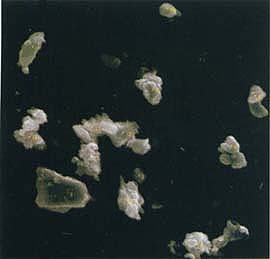All Issues
Trade Center air laden with very fine particles, DELTA scientists find
Publication Information
California Agriculture 56(3):84-84.
Published May 01, 2002
PDF | Citation | Permissions
Full text
In the most thorough analysis yet of the dust and smoke blown through lower Manhattan after the collapse of the World Trade Center, UC Davis scientists identified unprecedented clouds of very fine particles, which can be riskier to human health than larger, coarse particles.
"The air from Ground Zero was laden with extremely high amounts of very small particles, probably associated with high temperatures in the underground debris pile," says Thomas Cahill, UC Davis professor emeritus of physics and atmospheric sciences. "Normally, in New York City and in most of the world, situations like this just don't exist."
Cahill heads the UC Davis DELTA Group (Detection and Evaluation of Long-range Transport of Aerosols), a collaborative association of aerosol scientists at several universities and national laboratories, which monitors atmospheric conditions associated with global warming, weather, disasters and other events.
The DELTA Group collected air samples at the request of the U.S. Department of Energy from Oct. 2 through mid-December, with a rooftop air monitor about 1 mile north-northeast of Ground Zero.
The results for October were released in early February, and Cahill testified at an investigative hearing before the national ombuds-person for the U.S. Environmental Protection Agency on Feb. 23.
The samples were collected continuously in eight separate-size modes from coarse (12 micrometers diameter) to ultra-fine (0.09 micrometers diameter), and were analyzed for dozens of substances that are likely to be associated with burning office buildings.
Coarse particles are typically filtered by the nose or coughed out of the throat and upper lungs, but they can irritate the mucous membranes and aggravate pre-existing breathing problems such as asthma. Very fine particles, however, can travel deep into human lungs, and are typically removed from the lungs through the bloodstream and heart, increasing the possibility of more serious health impacts.
The UC Davis DELTA Group took air samples about a mile from the World Trade Center in early October 2001, several weeks after the towers collapsed. They Identified high levels of coarse particles, above, which included powdered concrete and glass with a coating of combustion products, in size range of 5 to 12 micrometers diameter. Very fine particles were found at levels not previously seen in ambient air samples.
In the largest spike, the DELTA Group analysis found 58 micrograms per cubic meter of very fine particles in one 45-minute period — “an extremely high peak,” Cahill says. “Even on the worst air days in Beijing, downwind from coalfired power plants, or in the Kuwaiti oil fires, we did not see these levels of very fine particulates.”
Virtually all the air samples from the trade center site also carried high concentrations of coarse particles. “These particles simply should not be there,” Cahill says. "It had rained, sometimes heavily, on 6 days in the prior 3 weeks. That rain should have settled these coarse particles." The finding suggests that coarse particles were being continually generated from the hot debris pile.
Some metals in the very fine mode, such as vanadium, were found at the highest levels ever recorded in air in the United States. Although some asbestos was used in the buildings for fireproofing and in floor tiles, the DELTA group found very few asbestos fibers, even in the very fine particles.
All evidence indicates that ambient air in New York City is no longer influenced by the World Trade Center collapse, especially since the fires are out and the debris pile has cooled, Cahill says. However, the presence of large amounts of very fine particles as late as October means that the cleanup of indoor air should be undertaken carefully, he warns. Very fine particles penetrate crevices and fabrics in a way that normal dust doesn't, and they are easily resuspended, which can re-expose the room's occupants.
For more information, go to: http://delta.ucdavis.edu.





